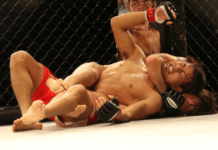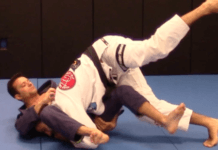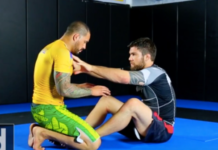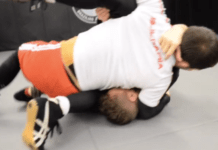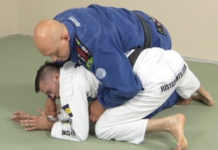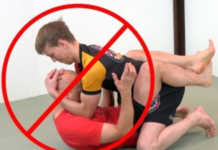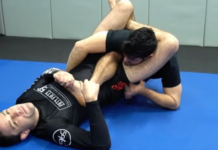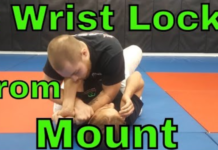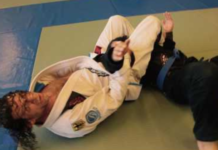Armbar is a characteristic BJJ technique, true classic and basis. You learn it practically at the beginning of your journey with Brazilian Jiu-Jitsu. It is very often and successfully used in competitions, both in gi and no-gi. It can be also used from almost any position. You can do it from the closed guard, from the mount, side control or from the back.
The Armbar from the closed guard
In a closed guard, you need to grab the opponent’s wrist and then grasp the triceps or collar with your other hand. Tip: it’s worth pulling the opponent closer to you. On the side of the attacked hand, we put the foot on the hip and guard the shoulder with our knee. Everything here needs to be tight. With the other leg, we do the swing as if we wanted to hit the opponent with the foot in the ear or back of the head. Then we twist and lay parallel to our opponent. The next step is to push his head and place our shinbones parallel to each other. The proper technique occurs when the hips are pushed up after immobilizing the opponent’s hand and placing the lower leg behind his head.
Remember! If the opponent’s thumb is pointing up, the surface of the technique is correct and causes hyperextension. Also, don’t forget to clamp your knees together. Thanks to them, the opponent cannot pull his head and take his hands. Tip: Grip with both hands provides maximum control. Typical mistake: when we move our legs, we forget to control the head or collar, which causes the opponent to run away from the lever.
The mount Armbar
Once we have this position, we can do the armbar on our initiative or for example when the opponent wants to throw us off and pushes his arms up. To perform the technique, we need to grab the opponent’s arm with the same hand we want to attack, i.e. right hand if we are attacking right elbow. Then we turn to position our knee close to the opponent’s head (we attack the right elbow, so it will be the left knee). We put the other leg (in this case the right one) on the foot close to the opponent’s hip. Tip: You will get full control by grabbing your triceps or collar, thanks to which your opponent’s hand will not slip. When our hands fully control the opponent’s arm, we must move the leg from the head of our opponent (here it will be left one) in a circular motion behind his head. When the leg is in front of the opponent’s head controlling his arm, we lie down on the back and by pushing our hips straighten his arm in the elbow.
Remember! To perform the technique, use all the strength of your back, it will give a better effect. Typical mistake: the knees are not together, the legs are loose or too wide apart. Then the whole grip is loose, the opponent got a lot of space to pull his elbow down to the floor and can easily escape from our armbar.
The side control Armbar
To do the correct armbar from this position, we need to start with passing the opponent’s hand closer to us. Only after its exclusion, we can move on to action. The first step is to grab the elbow and pull the opponent’s hand to yourself. His wrist should now be between our shoulder and head. When we have full control of the blocked arm, we can move the leg over the opponent’s head, everything is done low and close. After moving the leg behind the opponent’s head, we put the knee of another leg on the side of our opponent at the height of his armpit.
Remember! Keep your legs close, knees together, only then you can lean back. By using our back strength and pushing our hips up, we surrender our opponent. Attention! The technique should be carried out sensitively. Its quick implementation, with practically throwing yourself backward, can even lead to injury of the opponent. Speed is important, but we should always remember about the control and the people we train with. Typical mistake: your hips are too far away from your opponent’s shoulder. This reduces the amount of control you have and gives him lots of room to escape his elbow down to the floor.
The Armbar from the back control
Of the many basic positions, the back is one of the most effective. It can be used to perform a number of techniques, including suffocation with a transition to an armbar. Once we have achieved this dream position behind the opponent’s back, to initiate any further movements we should gently slide aside. This position allows suffocation and moving the leg behind the opponent’s head to make an armbar. For example, we go to stewing, our opponent breaks it, then we immediately push his head and thus make room for placing our leg in front of his head. Remember! Put your other leg on your opponent’s stomach, this prevents his escape. When we move the leg, the pressure caused by this turns the opponent on his back. The right lever occurs when the hips are pushed up after we achieved arm control.
No gi Armbar
Let’s remember that the armbar can also be done without a gi. For example, in a closed guard, our control will take place, simply by using direct hand grips, not a gi. Starting the technique, we grab the opponent’s wrist (not the sleeve) and with the other hand, we press on the forearm. Then instead of the collar, we control the opponent by holding his head, etc. All the mechanics remain the same, no matter if we have a gi or not. Remember the same things, the opponent’s thumb should be pointing up, legs should be kept close, knees together, etc.
Important! A typical mistake in every position is no control of the rotation of your opponent’s hand. His little finger should be on your chest. His thumb should be pointing up to the ceiling (or, alternately, pointing down towards your legs).
Is it easy ?
Is armbar an easy technique then? Basic for sure, but only seemingly easy. It might look like a simple move, but there is a lot of details about it. Armbar from different positions has its nuances that you need to master. Just remember to avoid typical mistakes and keep trying! After all, practice makes perfect.
Check also:
- Flying Armbar – Unorthodox BJJ Move to Finish your Fights Fast
- Learning and applying the triangle choke

